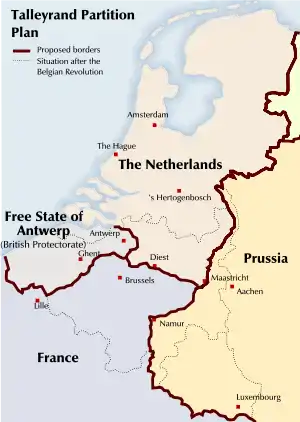Talleyrand partition plan for Belgium
The Talleyrand partition plan for Belgium was a proposal developed in 1830 at the London Conference of 1830 by the French ambassador to Britain Charles Maurice de Talleyrand, to partition Belgium. The proposal was part of the intensive negotiations among five great powers over the future of Belgium after the success of the Belgian revolution for independence.

Background
Despite increasing popular demands for independence, major European powers were divided over the future of Belgium; France was in favor of the secession of Wallonia, the territory inhabited by speakers of langues d'oil dialects, largely in hope of annexing those territories. Other European nations opposed the French demand, supporting the continued union of the Netherlands, which had been decided at the Congress of Vienna. A popular uprising spread like wildfire and ended Dutch rule in the Southern Netherlands, upsetting arrangements made at the Congress of Vienna. While Belgians formed provisional government in Brussels, major European powers were forced to consider alternative plans to contain the Belgicists and preserve its union with the Netherlands. Since Napoleonic times, Britain had been anxious that Antwerp ("a pistol pointing at the heart of London") should not be in the hands of a belligerent France.[1]
Plan
In lieu of the stalemate, Talleyrand proposed partitioning the Southern Netherlands:
- The province of Antwerp — except the city of Antwerp itself — and Limburg, west of the Meuse river — except Maastricht — would remain in the Netherlands, as would a small part of the province of Brabant, the former Oranje Lordship of Diest;
- The parts of the provinces of Liège, Limburg and Namur east of the Meuse river as well as the cities of Maastricht, Namur and Liège and the Grand Duchy of Luxembourg would go to Prussia;
- Part of the province of East Flanders, nearly all of the province of Brabant, the province of Hainaut and the province of Namur west of the Meuse would be assigned to France;
- West Flanders, most of East Flanders, including Zeelandic Flanders (which was not generally considered to be part of the Southern Netherlands as it had been under northern Dutch rule for centuries), and the city of Antwerp were to form the Free State of Antwerp, under British protection. It would have been more or less a restored County of Flanders at the river Scheldt.
Consequences
The Talleyrand plan was rejected by European powers, who ultimately approved a unified Belgian state. However, the Talleyrand plan was one of several ideas exploring the concept of partitioning Belgium, which is considered by some as simply a "buffer state" between France and other European nations. Modern proposals include the specific separation of the areas inhabited mainly by French-speakers (Walloons) from those inhabited mainly by (Flemish) Dutch-speakers; but one difficulty in this proposal is that mainly francophone Brussels lies within Flanders, not Wallonia. One should also note that there is currently no majority within the Belgian population for such a project and that the proportion of separatists in the country remains stable throughout the years.[2][3]
References
- Napoleon Bonaparte recognised the strategic value of Antwerp, and had ordered the building of the Napoleon Dock to house the French fleet.
- https://www.lesoir.be/271516/article/2020-01-08/seuls-16-des-electeurs-flamands-veulent-la-scission-du-pays
- https://www.standaard.be/cnt/dmf09112007_060
- The neutrality of Belgium: Chapter II - the London conference and the quintuple treaty Talleyrand, The Prince of diplomats
- Fishman, J. S. "The London Conference of 1830," Tijdschrift voor Geschiedenis (1971) 84#3 pp 418–428.
- Kelly, Linda (2017). Talleyrand in London: The Master Diplomat's Last Mission. London: I. B. Tauris. ISBN 978-1-78453-781-4.